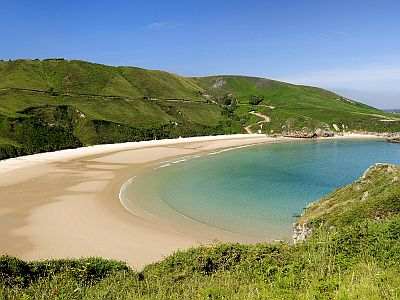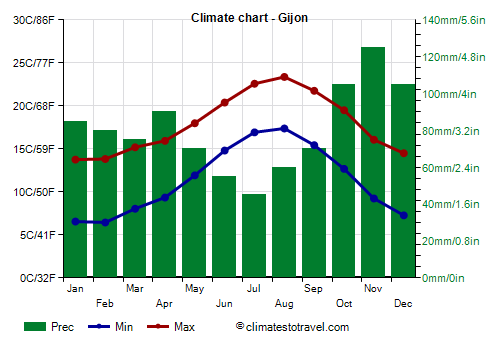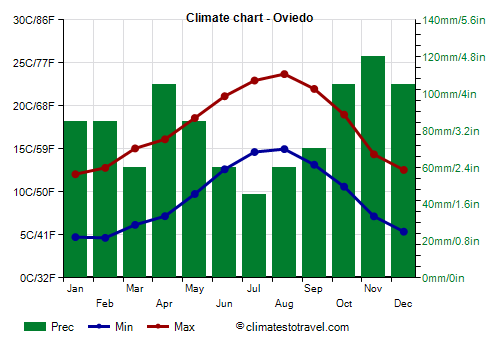Select units of measurement for the temperature and rainfall tables (metric or imperial).
Average weather, temperature, rainfall, sunshine hours
Index
Introduction
In the autonomous community of Asturias, in northern Spain, the climate is
cool and damp, being strongly influenced by the Atlantic Ocean. Winters are relatively mild and rainy, while summers are cool and cloudy. Atlantic frontal systems can affect this area all year round, although they are rarer in summer, when, however, drizzle and short showers may occur.
The
wind blows frequently, so there are several beaches frequented by surfers.
Fog is also common: it can show up all year round, when there is no wind, and even on summer nights, especially along the coast and in the valleys.
In winter, cold air masses from northern Atlantic Ocean and continental Europe can lead to cold and windy periods, but very cold days are rare on the coast (the cold records are a few degrees below freezing). However, even on mild days, the wind can increase the feeling of cold.
Snow, very rare on the coast, is a bit more frequent in inland hilly areas, for example in Oviedo, which is located at 230 meters (755 feet) above sea level. On the contrary, snowfalls can be abundant in the mountains.
Rainfall is quite abundant, in fact, it hovers around 1,000 millimeters (40 inches) per year on the coast and in hilly areas, and it is frequent, especially from October to May, while in summer, its frequency diminishes a bit. Owing to the abundance and frequency of rain, the landscape is green.
On the coast of Asturias, or
Green Coast, rugged and characterized by coves and natural caves, there are several beaches and resorts such as Cabo de Peñas, Luarca, Luanco,
Avilés, Gijón, Cudillero, Llanes and Ribadesella.

In the interior, we find hills, and in the southern part also a mountain range, the
Cantabrian Mountains, which separate this cool and moist part of Spain from the arid central plateau (called
Meseta). In particular, in the southeast stand out the
Picos de Europa ("Peaks of Europe"), whose highest peak is Torrecerredo, 2,648 meters (8,689 feet) high; these mountains receive heavy snowfalls in winter. There are also skilifts. Around a thousand meters (3,300 feet) of altitude, we find the Enol and Ercina lakes (also called Lakes of Covadonga).
In mountainous areas, there are parks, such as
Parque Natural de las Ubiñas - La Mesa,
Parque Natural de Somiedo, and
Parque Natural de Redes.
The wind that comes down from the mountains can cause rapid increases in temperature due to the
föhn effect: in these cases, the temperature along the coast can exceed 20 °C (68 °F) in winter and 30 °C (86 °F) in autumn and spring, while in summer, this warm wind is very rare.
Gijón

In
Gijón, the largest city, located on the coast, the average temperature goes from around 10 °C (50 °F) in January and February to 20.5 °C (69 °F) in August. Here are the average temperatures.
Gijon - Average temperatures (1991-2020) |
| Month | Min | Max | Mean |
|---|
| January | 6.6 | 13.8 | 10.2 |
|---|
| February | 6.4 | 13.8 | 10.1 |
|---|
| March | 8 | 15.2 | 11.6 |
|---|
| April | 9.4 | 15.9 | 12.6 |
|---|
| May | 11.9 | 18 | 15 |
|---|
| June | 14.8 | 20.4 | 17.6 |
|---|
| July | 16.9 | 22.6 | 19.8 |
|---|
| August | 17.4 | 23.4 | 20.4 |
|---|
| September | 15.4 | 21.8 | 18.6 |
|---|
| October | 12.7 | 19.5 | 16.1 |
|---|
| November | 9.2 | 16.1 | 12.7 |
|---|
| December | 7.3 | 14.5 | 10.9 |
|---|
| Year | 11.4 | 17.9 | 14.6 |
|---|
On average, 955 mm (37.5 in) of rain fall per year, with a maximum in autumn and a relative minimum in summer, when, however, there is no lack of rainy days.
Gijon - Average precipitation| Month | Days |
|---|
| January | 85 | 12 |
|---|
| February | 80 | 11 |
|---|
| March | 75 | 11 |
|---|
| April | 90 | 12 |
|---|
| May | 70 | 11 |
|---|
| June | 55 | 7 |
|---|
| July | 45 | 6 |
|---|
| August | 60 | 8 |
|---|
| September | 70 | 8 |
|---|
| October | 105 | 11 |
|---|
| November | 125 | 13 |
|---|
| December | 105 | 13 |
|---|
| Year | 955 | 124 |
|---|
The
sea along the coast of Asturias is a bit cold even in summer, since it reaches 19 °C (66 °F) in July and 20 °C (68 °F) in August.
Gijon - Sea temperature| Month |
|---|
| January | 13 |
|---|
| February | 13 |
|---|
| March | 13 |
|---|
| April | 13 |
|---|
| May | 14 |
|---|
| June | 17 |
|---|
| July | 19 |
|---|
| August | 20 |
|---|
| September | 19 |
|---|
| October | 18 |
|---|
| November | 16"> |
|---|
| December | 14 |
|---|
| Year | 15.8 |
|---|
Oviedo

In the capital,
Oviedo, which, as mentioned, is located at 230 meters (755 ft) above sea level, the temperatures are similar to those of Gijón, although they are a bit lower at night and in winter.
Oviedo - Average temperatures (1991-2020) |
| Month | Min | Max | Mean |
|---|
| January | 4.8 | 12.1 | 8.4 |
|---|
| February | 4.7 | 12.8 | 8.7 |
|---|
| March | 6.2 | 15.1 | 10.6 |
|---|
| April | 7.2 | 16.1 | 11.6 |
|---|
| May | 9.8 | 18.6 | 14.2 |
|---|
| June | 12.6 | 21.1 | 16.9 |
|---|
| July | 14.6 | 23 | 18.8 |
|---|
| August | 15 | 23.7 | 19.3 |
|---|
| September | 13.2 | 22 | 17.6 |
|---|
| October | 10.6 | 19 | 14.8 |
|---|
| November | 7.2 | 14.4 | 10.8 |
|---|
| December | 5.4 | 12.6 | 9 |
|---|
| Year | 9.3 | 17.6 | 13.4 |
|---|
In Oviedo 1,005 mm (40 in) of rain fall per year; summer is the least rainy season, but it rains 8/9 days per month also from June to August (or in September, when the weather is somewhat similar).
Oviedo - Average precipitation| Month | Days |
|---|
| January | 85 | 11 |
|---|
| February | 85 | 11 |
|---|
| March | 60 | 11 |
|---|
| April | 105 | 13 |
|---|
| May | 85 | 13 |
|---|
| June | 60 | 9 |
|---|
| July | 45 | 8 |
|---|
| August | 60 | 8 |
|---|
| September | 70 | 8 |
|---|
| October | 105 | 12 |
|---|
| November | 120 | 13 |
|---|
| December | 105 | 12 |
|---|
| Year | 1005 | 128 |
|---|
The amount of
sunshine in Asturias is not very good: in July and August, there are 5.5/6 hours of sunshine per day in cities like Avilés, Oviedo and Gijón; in the other seasons, and especially in late autumn and winter, it is not better, and the sky is often cloudy.
Oviedo - Sunshine hours| Month | Average | Total |
|---|
| January | 3.5 | 115 |
|---|
| February | 4.5 | 120 |
|---|
| March | 5 | 155 |
|---|
| April | 5.5 | 160 |
|---|
| May | 5.5 | 165 |
|---|
| June | 5.5 | 165 |
|---|
| July | 5.5 | 175 |
|---|
| August | 5.5 | 175 |
|---|
| September | 5.5 | 165 |
|---|
| October | 4.5 | 140 |
|---|
| November | 3.5 | 110 |
|---|
| December | 3.5 | 105 |
|---|
| Year | 4.8 | 1755 |
|---|
Best Time
The
best period to visit Asturias is the summer, from June to August or the first half of September, since it is the driest and sunniest time of the year. July and August are the warmest and least rainy months. Even in midsummer, we must take into account some rain, and some nights a bit cool on the coast and a bit cold in inland areas.
In summer, in good weather, you can take a break at the beach and sunbathe, with an air temperature often pleasant and a cool breeze from the ocean, although, as I said, the sea is a bit cold for swimming.
Back to topSee also the
temperatures by month.